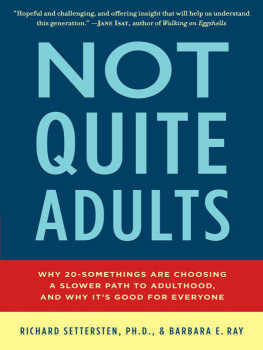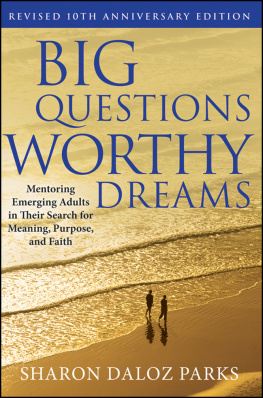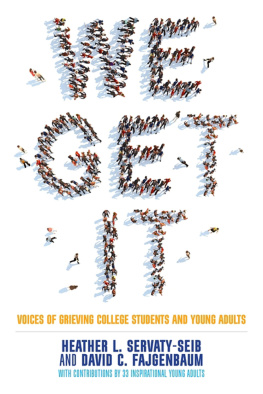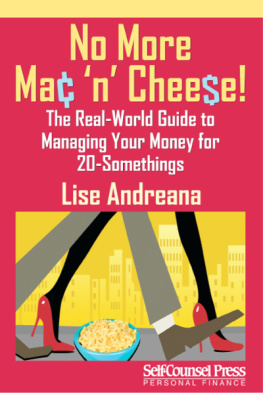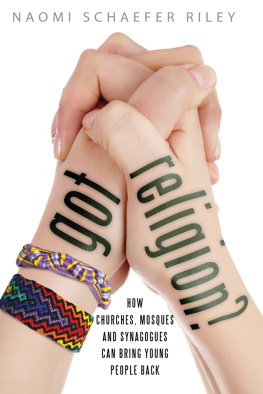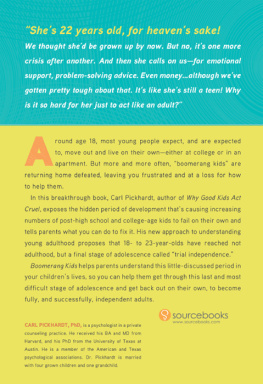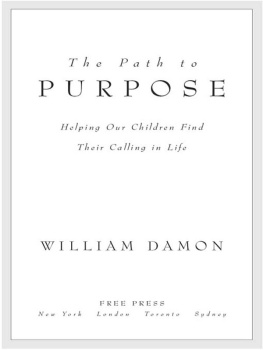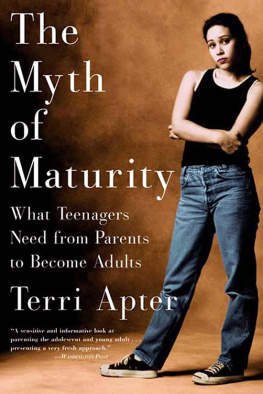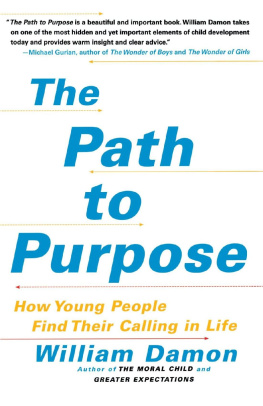MORE PRAISE FOR
NOT QUITE ADULTS
There are three huge strengths that set this book apart from anything else available on the transition to adulthood. First, it is written in a lively and jargon-free style by two rare social scientists who are familiar with the English language. Second, its scope is stunning, including challenges to becoming an adult created by dramatic changes in education, relations between young adults and parents, marriage and its precursors, civic life, and the world of work. Third, the tone is relentlessly upbeat about the advantages these changes are opening up for young people. This book proves that it is possible to write an interesting book about a big social problem that reflects research knowledge while nonetheless being accessible to the American public.
R ON H ASKINS , co-director of the Brookings Institutions Center on Children and Families
One of the most important functions of social science research is to raise the quality of public debate by challenging myth, conjecture, and sensationalism with empirical realities. This book does just that by presenting an integrated social map of young adulthood in twenty-first-century America that is grounded in a diverse body of research.
J AMES G ARBARINO , P H .D., Loyola University Chicago, author of Children and the Dark Side of Human Experience
Amid all the outcry over young people stuck in adultolescence and failing to launch comes this sensible portrait of a generation of almost-adults. Based on empirical research, and not hand-wringing punditry, Settersten and Ray reveal a new stage of development that slows the clock, but does not stop it, making slower, but steady progress to more durable relationships and stable social networks.
M ICHAEL K IMMEL , professor of sociology, SUNY Stony Brook, author of Guyland: The Perilous World Where Boys Become Men
The rulebook has changed; the good ol days of a universally accepted school-work-family-retirement fast track are gone. Despite mainstream medias attempt to portray 20-somethings as a group of lazy, no-good slackers, Not Quite Adults uncovers the real storyhow a slower, more calculated transition into adulthood often makes more sense and leads to a better future for us all.
S EAN A IKEN , author of The One-Week Job Project
A provocative look at how a changing reality is transforming the transition to adulthood for a generation of Americans, and the implications of this transformation in todays competitive world.
Kirkus Reviews
Aside from enjoying a panoramic perspective on one generation, readers will be able to glean tips on everything from dating to parenting from this admirably lucid and fair-minded study that, in describing what is happening, reveals what is working.
Publishers Weekly
Not Quite Adults is perhaps the most important contribution to date about the strange new life of Americas twenty-somethings. Settersten and Ray are able to combine a deep grasp of the research with commonsense advice for not quite adults and their parents. The slower path to adulthood is here to stay; thanks to the authors, we are now much wiser about what that means for all of us.
K AY H YMOWITZ , author of Manning Up: How the Rise of Women Has Turned Men Into Boys and contributing editor for City Journal
Based on interviews with 500 young adults and extensive research, this outstanding book offers a fresh and compelling view of why it is taking this generation longer to make career and family decisions. The message here is about the value of slowing down, and it makes sense not just for young adults, but also for their parents and educators, who are fast-tracking children into a lengthy period of being nearly, but not quite, adults. Learn about todays young adults, why they are making the life choices they are, and why we should feel good about it.
B ARBARA S CHNEIDER , author of The Ambitious Generation , John A. Hannah Distinguished Professor, Michigan State University

A Bantam Books Trade Paperback Original
Copyright 2010 by Richard Settersten, Jr., and Barbara Ray
All rights reserved.
Cover design: Georgia Feldman
Published in the United States by Bantam Books, an imprint of The Random House Publishing Group, a division of Random House, Inc., New York.
B ANTAM B OOKS and the rooster colophon are registered trademarks of Random House, Inc.
eISBN: 978-0-440-33979-3
www.bantamdell.com
v3.1
Contents
MacArthur Research Network
on Transitions to Adulthood and Public Policy
Frank F. Furstenberg, Jr. , PhD, network director, University of Pennsylvania
Gordon Berlin , PhD, MDRC
Mark Courtney , PhD, University of Washington
Sheldon Danziger , PhD, University of Michigan
Connie A. Flanagan , PhD, Pennsylvania State University
Vonnie C. McLoyd , PhD, University of North CarolinaChapel Hill
D. Wayne Osgood , PhD, Pennsylvania State University
Jean E. Rhodes , PhD, University of MassachusettsBoston
Cecilia E. Rouse , PhD, Princeton University
Rubn G. Rumbaut , PhD, University of CaliforniaIrvine
Richard A. Settersten, Jr. , PhD, Oregon State University
Mary Waters , PhD, Harvard University
Barbara Ray , Hiredpen, Inc., communications director
Patricia Miller , University of Pennsylvania, administrator
Associate Members
Thomas Brock , PhD, MDRC
Patrick Carr , PhD, Rutgers University
Colleen Dillon , PhD, University of Washington
E. Michael Foster , PhD, University of North CarolinaChapel Hill
Elizabeth Fussell , PhD, Washington State University
Douglas Hartmann , PhD, University of Minnesota
Jennifer Holdaway , PhD, Social Science Research Council
Maria Kefalas , PhD, St. Josephs University
Teresa Swartz , PhD, University of Minnesota
Introduction
T here was a time not so long ago when a popular high school graduation gift was a suitcase. Not for nothing, this gift. It marked the young person as a newly minted member of the adult clan, bound for independence and autonomy. Armed with a wallet full of small bills from family, friends, and neighbors, and either a dictionary for college or a pair of new work boots for the factory floor, high school graduates set off to conquer the world with their suitcases in tow.
Young adults once hit the road on a clearly marked path. The first stop was college, some training, or the military. Next up was a job. Marriage followed, and then children. Between marriage and kids, the new family bought a home. All of this was accomplished by age twenty-fiveand often in that order. There would be exceptions and a few detours for some, but for the majority, the gap between the end of adolescence and the embrace of adulthood was short and sweet. This sprint was not confined to the halcyon days of the 1950s. The suitcase and the quick ticket to independence were alive and well for the high school class of 1980.
From the vantage point of parents and eighteen-year-olds today, this beeline to adulthood is unfathomable. Move out? Who can afford it? A college degree and a job by age twenty-oneno way. Marriage and kids by twenty-five? Unheard of. Today, one-half of those between eighteen and twenty-four have not left their childhood bedrooms, let alone landed a job, married, or had children of their own. This is a 37 percent increase over 1970. And an even bigger jump in living at home has occurred for those ages twenty-five through thirty-foura 139 percent increase since 1970. Some of these young people never left the nest, and others have boomeranged back. Regardless, this sizable increase is a strong clue to how much the transition into adulthood is stretching. Todays graduation gift might as well be a GPS device, because the signposts on the road to adulthood seem to have all but vanished.
Next page
